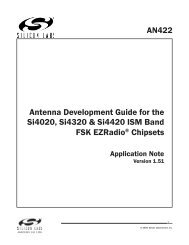C8051F326/7 - Silicon Labs
C8051F326/7 - Silicon Labs
C8051F326/7 - Silicon Labs
Create successful ePaper yourself
Turn your PDF publications into a flip-book with our unique Google optimized e-Paper software.
<strong>C8051F326</strong>/7<br />
7.3. External Reset<br />
The external RST pin provides a means for external circuitry to force the device into a reset state. Asserting<br />
an active-low signal on the RST pin generates a reset; an external pullup and/or decoupling of the RST<br />
pin may be necessary to avoid erroneous noise-induced resets. See Table 7.1 for complete RST pin specifications.<br />
The PINRSF flag (RSTSRC.0) is set on exit from an external reset.<br />
7.4. Missing Clock Detector Reset<br />
The Missing Clock Detector (MCD) is a one-shot circuit that is triggered by the system clock. If more than<br />
100 µs pass between rising edges on the system clock, the one-shot will time out and generate a reset.<br />
After a MCD reset, the MCDRSF flag (RSTSRC.2) will read ‘1’, signifying the MCD as the reset source;<br />
otherwise, this bit reads ‘0’. Writing a ‘1’ to the MCDRSF bit enables the Missing Clock Detector; writing a<br />
‘0’ disables it. The state of the RST pin is unaffected by this reset.<br />
7.5. Flash Error Reset<br />
If a Flash read/write/erase or program read targets an illegal address, a system reset is generated. This<br />
may occur due to any of the following:<br />
• A Flash write or erase is attempted above user code space. This occurs when PSWE is set to ‘1’ and a<br />
MOVX write operation is attempted above address 0x3DFF.<br />
• A Flash read is attempted above user code space. This occurs when a MOVC operation is attempted<br />
above address 0x3DFF.<br />
• A Program read is attempted above user code space. This occurs when user code attempts to branch<br />
to an address above 0x3DFF.<br />
• A Flash read, write or erase attempt is restricted due to a Flash security setting (see Section<br />
“8.3. Security Options” on page 65).<br />
The FERROR bit (RSTSRC.6) is set following a Flash error reset. The state of the RST pin is unaffected by<br />
this reset.<br />
7.6. Software Reset<br />
Software may force a reset by writing a ‘1’ to the SWRSF bit (RSTSRC.4). The SWRSF bit will read ‘1’ following<br />
a software forced reset. The state of the RST pin is unaffected by this reset.<br />
7.7. USB Reset<br />
Writing ‘1’ to the USBRSF bit in register RSTSRC selects USB0 as a reset source. With USB0 selected as<br />
a reset source, a system reset will be generated when either of the following occur:<br />
1. RESET signaling is detected on the USB network. The USB Function Controller (USB0) must<br />
be enabled for RESET signaling to be detected. See Section “12. Universal Serial Bus Controller<br />
(USB0)” on page 87 for information on the USB Function Controller.<br />
2. The voltage on the VBUS pin matches the polarity selected by the VBPOL bit in register<br />
REG0CN. See Section “5. Voltage Regulator (REG0)” on page 31 for details on the VBUS<br />
detection circuit.<br />
The USBRSF bit will read ‘1’ following a USB reset. The state of the RST pin is unaffected by this reset.<br />
60 Rev. 1.1


